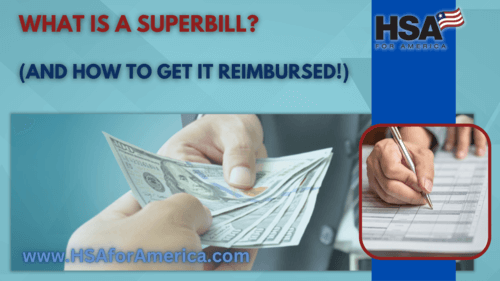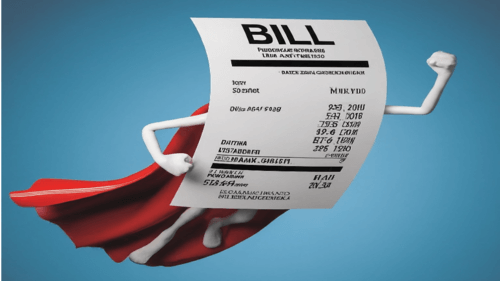
A “superbill” is not a bill at all.
And it’s not all that “super.”
Instead, a superbill is a consolidated receipt of services you received from your healthcare provider, which they provide you with after your visit.
And if you are enrolled in a health sharing plan, or you go “out of network” in a traditional health insurance plan, understanding what a superbill is and how it works is critical to getting some or all of these expenses reimbursed.
Superbills make OON benefits more accessible by providing a straightforward way to get back everything your plan covers. If you’ve ever seen a provider such as a dietitian or mental health counselor and paid out-of-pocket, you most likely received a superbill and didn’t even realize it.
This article will explain in more detail what a superbill is, what should be included, and how you can use it to get your covered or shareable medical expenses reimbursed by your health sharing plan or traditional health insurance plan.

Compare Pricing on the Best Insurance Plans Available
How Superbills Work
If you have a traditional health insurance plan with an HMO or EPO, your visits are only covered if you see providers within their approved network.
In that case, the providers will most likely bill your insurance company directly, and you won’t have to worry much about the superbill.
With a PPO, you might be able to see providers out-of-network and get some of your expenses reimbursed.
In the past, there was a lot of confusion between what was and wasn’t “in-network.” The recent No Surprises Act now requires doctors and hospitals to be more clear about out-of-network costs up front, so you can make a more informed decision about whether to seek care with those providers.
Going “Out of Network”
When you decide to visit an Out-of-Network (OON) provider, they may not bill your insurance company directly.
Instead, you may need to pay the entire amount up front, or arrange a payment plan with the provider. Then then submit all the information yourself to your insurance company yourself before your carrier will reimburse you for the covered amount (minus your deductible and any coinsurance or copay amounts).
That’s where the superbill comes in!
It’s an itemized receipt showing all the services you paid for. Don’t throw it away: you’ll need all those details to get your medical expenses reimbursed by your health plan.
Some people mistakenly assume their insurance won’t cover any out-of-network care at all.
However, this is not normally the case for emergency care, or for PPOs and HMOs. Exclusive care providers (EPOs), on the other hand, will cover little or no non-emergency care out of network.
However, if you’re enrolled in any of these traditional managed care-style plans, or a health sharing plan, it’s very important to understand how your superbill works, and how to get reimbursed.
Learn More: How to Avoid Out-of-Network Fees
What’s Included in a Superbill?
Your superbill lists all the services you received, the cost, and the specific healthcare codes associated with those services.
This is all the information your insurance company needs to determine how much they will cover, which is the amount they will send back to you – if you do your paperwork right!
Here’s what you’ll see on each superbill:
- Provider Details. Your healthcare provider’s name, contact information, and tax ID number
- Patient Information. Your name, date of birth, and insurance details
- Visit Date. The specific day you received services
- Procedure Codes. The Current Procedural Terminology (CPT) codes that describe the specific medical services you received
- Diagnosis Codes. The ICD-10 codes that identify your medical condition or reason for the visit
- Service Fees. You should see an itemized cost for each service, not just a total amount, as some services may be covered, and others may not be.
Tip: Submit every superbill you receive. Even if your carrier doesn’t reimburse you anything, your superbill can help you get credit for amounts you pay towards your deductible.
Frustrated By Narrow Care Networks? Consider Health Sharing
If you find yourself needing to see OON providers frequently, you may want to consider switching to a health sharing plan that lets you see any doctor you choose, rather than restricts you to their narrow network of approved providers.
Most health sharing plans don’t have any networks at all, so you are free to choose any provider you’d like, at any time. There are no OON headaches to worry about!
You may still have to pay a portion of the bill, and then send it in to be shared. And what services are eligible varies depending on your plan. But the process is usually much easier than what is required from insurance companies. And your costs may be even less!
How to Get a Superbill
Getting a superbill is straightforward:
After your healthcare visit, simply request a superbill as you are leaving. Most providers understand why you need it, and can quickly generate one for you.
Here’s the process:
- After your visit with an out-of-network provider, present your insurance card or healthshare card.
- If you pay them directly for any of the services you received, ask the provider to give you a superbill.
- Submit the superbill to your insurance company showing them what specific services you received, and how much you paid.
- The insurance company will reimburse you directly for your covered expenses – either by check or direct deposit.
Check everything carefully before you send it in to make sure it’s complete and correct. Errors or omissions could delay or prevent getting reimbursed.
Submitting Your Superbill
Before you file the claim and submit your superbill for reimbursement, it’s a good idea to contact your plan’s “out of network” desk, or “OON specialist.”
If you have a traditional health insurance plan (rather than a health sharing plan), here are a few questions to ask your OON specialist:
- Does your plan have OON benefits?
- What is my deductible?
- Have I met my deductible?
- Are the services on my superbill covered (or shareable, if you’re in a health sharing plan)?
- What percentage does your insurer cover for OON services? (This is the amount you would be getting back.)
- Is there a coinsurance rate? What portion of the total bill is your responsibility?
Follow up
Once you submit your superbill for reimbursement, be patient: It often takes a few weeks.
If you don’t get anything back after about a month, call to make sure they have everything they need, and that there are no issues holding up your money.
You may need to call more than once to keep the process moving. But persistence pays off!
Receive payment
Once you get your reimbursement or decision letter, look for the Explanation of Benefits (EOB) that should come with it.
The EOB confirms that your claim has been processed, and details how the insurance company decided what to pay. It will outline:
- The services that were submitted via the superbill
- The amount billed for the service by the provider
- Any adjustments made based on the insurance company’s policies or negotiated rates
- The amount the insurance company has agreed to cover
- Deductibles, co-insurance, or co-payment amounts that are your responsibility
- The total amount, if any, you still owe to the provider
Check the EOB carefully to make sure your benefits were applied correctly.
If there are discrepancies, contact your insurance company right away. Mistakes happen, and you may need to dispute them if you feel there was an issues
Don’t get discouraged. Make the corrections and resubmit.
Why You Should Submit Every Superbill
Automatically submitting a superbill to your insurance company after all your healthcare visits provides several benefits:
- Meet Deductibles – Submitting a superbill for an insurance-covered visit can help you reach your deductible faster, and documents what you have paid.
- Maximize Reimbursement – You’ll automatically get back any OON portion that is covered.
- Less Confusion – You won’t stress so much over which providers and services are covered and which aren’t – just send the superbill and let the insurance company do the math work.
- Clarify Benefits – The process of submitting superbills and receiving EOBs in response can show you exactly how your insurance plan works, what it covers, and the proportions of coverage.
- Evidence of Medical Expenses – Superbills and the corresponding EOBs serve as official records of your healthcare spending. This can be useful for tax purposes, especially if you’re claiming medical expenses deductions, or for personal finance tracking.
Superbills can also be useful for showing damages if you are suing someone for compensation related to your injury or illness.
A superbill helps bridge the gap between you and your health insurance. It’s even helpful if you are part of a health sharing plan.
It’s an easy way to document all your healthcare services, and get back all the money you’re entitled to
Compare Pricing on the Best HealthShare Plans Available
Superbill Conclusion
A superbill is a detailed receipt provided by healthcare providers after a visit, itemizing the services rendered. It’s essential for patients seeking reimbursement from their insurance or health sharing plans, especially when using out-of-network providers.
Key components of a superbill include:
- Provider Details: Name, contact information, and tax ID number.
- Patient Information: Name, date of birth, and insurance details.
- Visit Date: The specific day services were provided.
- Procedure Codes: Current Procedural Terminology (CPT) codes describing the medical services.
- Diagnosis Codes: ICD-10 codes identifying the medical condition or reason for the visit.
- Service Fees: Itemized costs for each service.
To obtain a superbill, request one from your healthcare provider after your visit. Submit it to your insurance company to facilitate reimbursement for covered expenses. Ensure all information is accurate to prevent delays in processing.
For more information on how to make the most of your healthcare options, including health sharing plans and HSAs, reach out to a Personal Benefits Manager today. They’re ready to guide you through your options and help maximize your savings.
For Further Reading: Best Health Share Plans Comparison Guide | Escape From Healthcare Narrow Networks: How You Can Finally Choose Your Own Doctor! | Why You Should Use Independent Doctors



